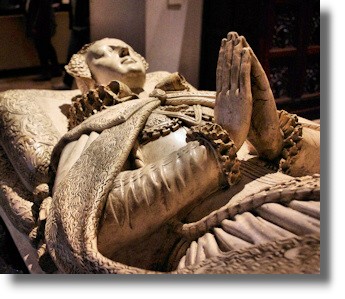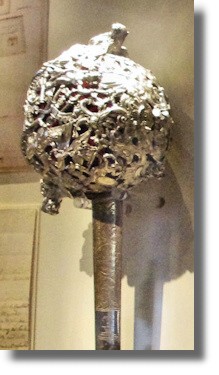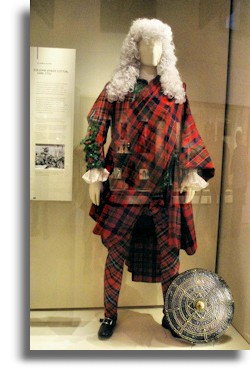

Not just Kings, Queens and Princes but also some other Scots who made a contribution to the country's development.
Mary Queen of Scots
The picture at the top of this page is of the tomb of Mary Queen of Scots. Mary was born on 8 December 1542, six days before her father, King James V, died. In July 1543, King Henry VIII arranged for Mary to be betrothed to his son, Prince Edward - an arrangement which was rejected by the Scots parliament. A few months later, in September 1543, aged 9 months, she was crowned at Stirling Castle. In 1558 Mary married the Dauphin of France - she was 15, he was 14. The following year she became Queen of France as well as Scotland when her husband became King Francis II. But he died the following year and Mary returned to Scotland. She met Lord Darnley in February 1565 and married him five months later. She gave birth to her son, who was to become James VI, on 19 June 1566.After Darnley's death in February 1567, she married the earl of Bothwell (at 4am) on May 15 the same year. Her continued advocacy of Catholicism, at a time when John Knox was strenuously implementing the Reformation, led to her being forced to abdicate in favour of her son in July 1567. An attempt to reagain power led to her defeat at the Battle of Langside in 1568 and she fled to her cousin, Queen Elizabeth of England. Elizabeth imprisoned her and eventually had her beheaded at Fotheringay Castle in 1587.
King James VI
Son of Mary Queen of Scots and Lord Darnley, James VI was born on 19 June 1566 and inherited the throne a year later when Mary abdicated. James grew up in Stirling Castle and was crowned there in 1567 at the age of 13 months - having to listen to an interminable sermon from John Knox as part of the ceremony. He married Anne of Denmark in 1590. A skilful if ruthless monarch, at 37 he became King of both Scotland and England in 1603 on the death of Queen Elizabeth I of England. He left Edinburgh for London on 2 April 1603 and returned only once to Scotland.
Charles Edward Stewart

Bonnie Prince Charlie, son of James Francis Edward Stewart (the "Old Pretender") and grandson of King James VII, was born in Rome on 31 December 1720. He landed on Eriskay on 23 July 1745, hoping to regain the throne for the Stewarts. He raised his standard at Glenfinnan on 19 August, thus staring the '45 Jacobite Rebellion or the '45 Uprising, depending on which side you were on. He reached Edinburgh on 17 September and his army, under Lord George Murray, defeated the Government forces under Sir John Cope at Prestonpans on 21 September. The Jacobites marched south and reached Derby on 6 December. But with no support from Lowland Scotland and with the Highlanders keen to return home, the army turned back. They defeated the pursuing forces at Falkirk in January 1746 but the Government forces, now under the command of the Duke of Cumberland, caught up with the depleted Jacobites at Culloden on 16 April 1746 in the last pitched battle on British soil. Charles avoided capture for five months before departing by ship to France.
The ornate backsword illustrated on the left belonged to Bonnie Prince Charlie, having been presented by the 3rd Duke of Perth. The sword is from the Royal collection and it is assumed that it was captured by the Duke of Cumberland's troops and presented to King George II by the victorious general.
William Cumming
In amongst all the Kings, Queens and Princes it is good to see this famous painting of William Cummings, who was the piper to the Laird of Glen Grant. It was painted in 1714 by Richard Waitt. In the museum context it is hung in a striking position surrounded by other object from Gaeldom.

Sir John Hynde Cotton
This striking tartan outfit, including the Highland targe or shield, belonged to Sir John Hynde Cotton of Maddingley Hall in Cambridgeshire. He lived from 1686 to 1752 and was a prominent English Jacobite. In 1744 he visited Edinburgh and was granted the freedom of the city. He has been called "one of the most zealous Jacobites in England". Prime Minister Horace Walpole wrote that Cotton "had wit and the faithful attendant of wit, ill nature; and was the greatest master of the arts of the House of Commons, where he seldom made but short speeches, having a stammering in his elocution, which however he knew how to manage with humour."
Sir Jackie Stewart
Sir Jackie Stewart was born in Dumbartonshire on 11 June 1939. Suffering from dyslexia, he left school at the earliest opportunity and entered his father's business as an apprentice. The firm sold Jaguars and Jackie soon became involved in motor racing (like his elder brother) with Ecurie Ecosse. But his brother was injured in a crash at Le Mans and Jackie was encouraged to take up a safer sport - he nearly made the UK Olympic team at shooting in 1960.
However, in 1963 Ken Tyrrell who offered him a place on his F3 team. Stewart moved on to BRM and Formula 1 in 1965 and won his first Grand Prix at Monza in Italy, finishing third in the World Championship in his first season. He later rejoined Ken Tyrrell and won 27 Grand Prix races out of 99 starts. He became World Champion in 1969, 1971 and 1973 and was runner-up in 1968 and 1972. He retired after winning his last Championship. His total of 27 wins was not equalled for 20 years.
Early in his career, following a crash which showed him the poor standard of safety and medical care at races in those days, he started to campaign vigorously for improved standards, with considerable success. He once said "The champion doesn't judge himself against others. He measures himself against his own standards."
Having retired from racing, he took up commentating on the sport and pursued a number of business interests. In 1995 he came back to motor racing as owner of his own Formula One team. He attracted sponsorship from Ford, HSBC and other backers. But his team was one of the few in the sport which did not take sponsorship from the tobacco companies. His son joined the team - with its distinctive tartan flashes - as manager. His cars came second at Monaco and third at San Marino in 1998/99 season. In 1999, Stewart sold his Grand Prix racing team to Ford for 100 million pounds.
More Pages on the Museum of Scotland
Return to the Main Index of Places to Visit
Where else would you like to go in Scotland?

